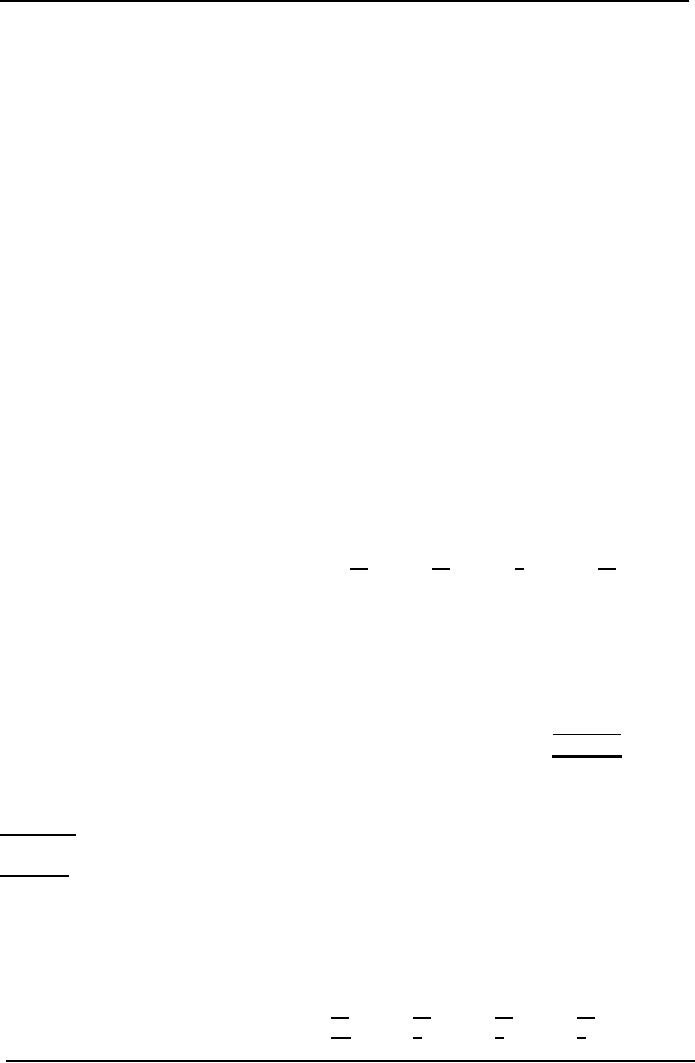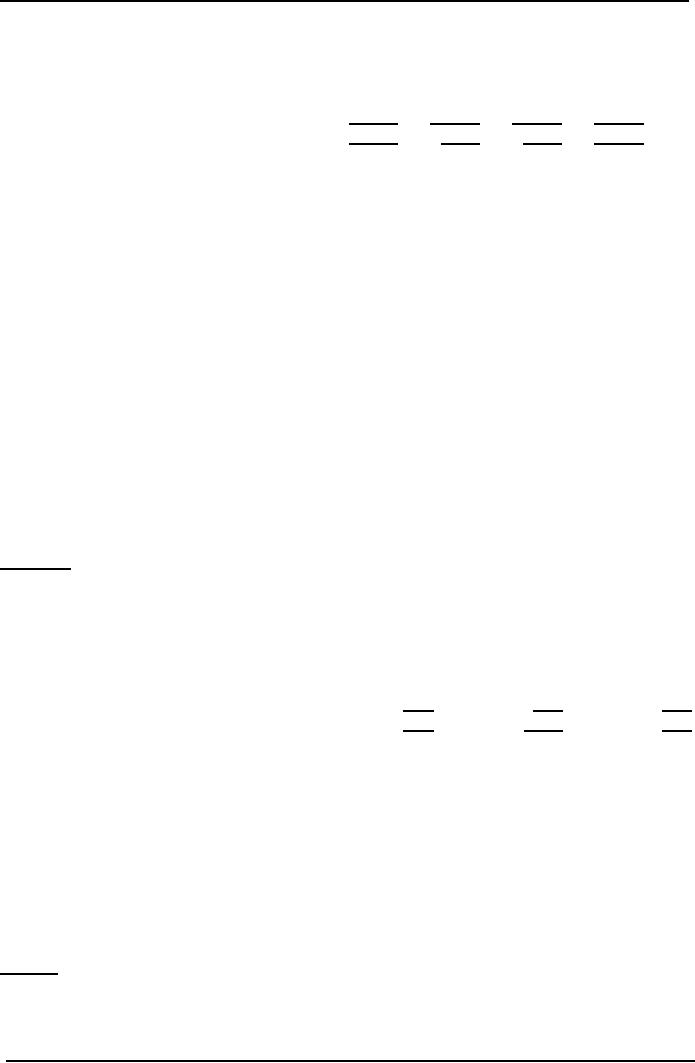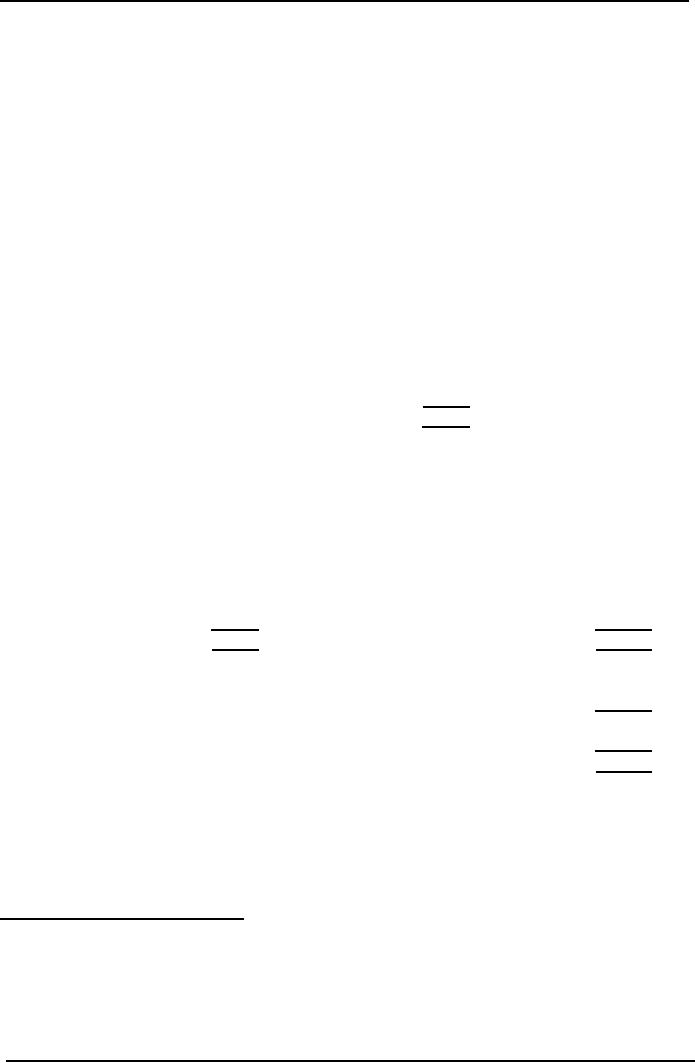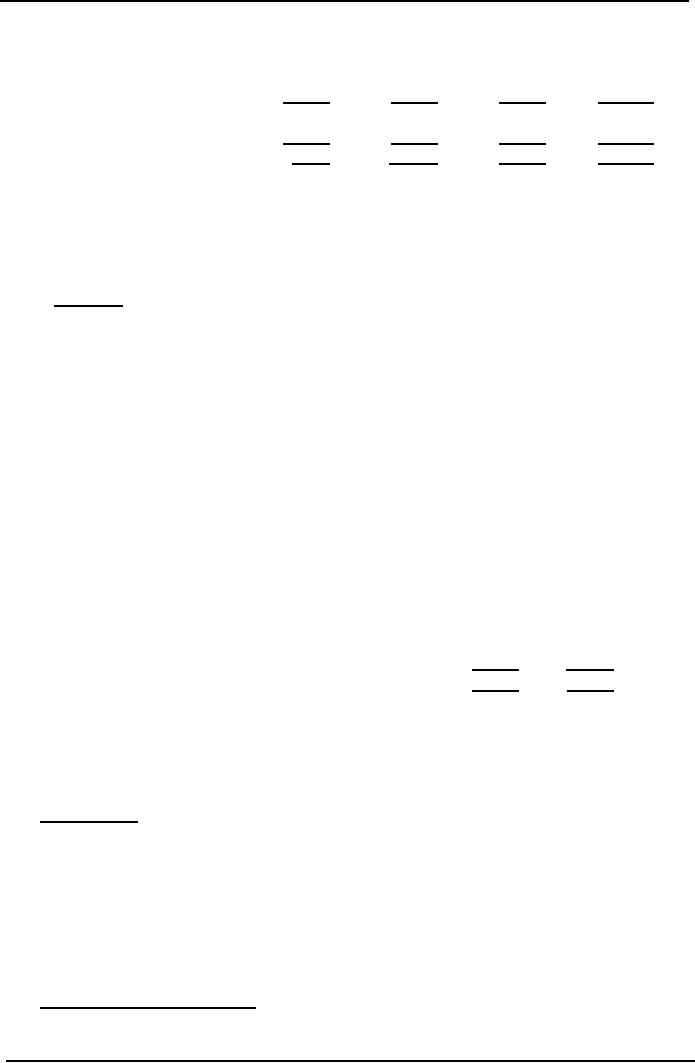 |
DECISION MAKING CHOICE OF PRODUCT (PRODUCT MIX) DECISIONS:MAKE OR BUY DECISIONS |
| << DECISION MAKING CHOICE OF PRODUCT (PRODUCT MIX) DECISIONS |

Cost
& Management Accounting
(MGT-402)
VU
MAKE
OR BUY DECISIONS
Introduction
In a
make or buy situation with
no limiting factors, the relevant
costs for the decision
are the
differential
costs between the two
options.
A
make or buy problem involves
a decision by an organization about
whether it should make
a
product/carry
out an activity with its own
internal resources, or whether it
should pay another
organization
to make the production/carry
out the activity. Examples of
make or buy decisions
would
be as follows.
a.
Whether a company should
manufacture its own components, or
buy the components
from
an outside supplier.
b.
Whether a construction company
should do some work with its
own employees, or
whether
it should subcontract the
work to another
company.
It
an organization has the
freedom of choice about
whether to make internally or
buy externally
and
has no scarce resources that
put a restriction on what it
can do itself, the relevant
costs for
the
decision will be the
differential costs between
the two options.
Example:
Make or Buy
Buster
Ltd makes four components,
W, X, Y and Z, for which
costs in the forthcoming
year are
expected
to be as follows.
W
X
Y
Z
Production
(units)
1,000
2,000
4,000
3,000
Unit
marginal costs
Rs.
Rs.
Rs.
Rs.
Direct
materials
4
5
2
4
Direct
labor
8
9
4
6
Variable
production overheads
2
3
1
2
14
17
7
12
Directly
attributable fixed cost per
annum and committed fixed
costs are as follows:
Rs.
Incurred
as a direct consequence of making W
1,000
Incurred
as a direct consequence of making X
5,000
Incurred
as a direct consequence of making Y
6,000
Incurred
as a direct consequence of making Z
8,000
Other
fixed costs
(committed)
30,000
50,000
A
subcontractor has offered to
supply units of W, X, Y and Z
for Rs. 12, Rs.
21, Rs. 10, and
Rs. 14
respectively.
Required:
Decide
whether Buster Ltd should
make or buy the
components.
Solution:
a.
The
relevant cots are the
differential costs between making
and buying, and they
consist
of
difference in unit variable costs
plus differences in directly attributable
fixed costs.
Subcontracting
will result in some fixed
cost savings.
W
X
Y
Z
Rs.
Rs.
Rs.
Rs.
Unit
variable cost of making
14
17
7
12
Unit
variable cost of
buying
12
21
10
14
(2)
4
3
2
W
X
Y
Z
243

Cost
& Management Accounting
(MGT-402)
VU
Annual
requirements (units)
1,000
2,000
4,000
3,000
Rs.
Rs.
Rs.
Rs.
Extra
variable cost of buying (per
annum)
(2,000)
8,000
12,000
6,000
Fixed
costs saved by buying
(1,000)
(5,000)
(6,000)
(8,000)
Extra
total cost of buying
(3,000)
3,000
6,000
(2,000)
b.
The
company would save Rs.
3,000 pa by subcontracting component W
(where the purchase
cost
would be less than the
marginal cost per unit to
make internally) and would
save Rs.
2,000
pa by subcontracting component Z (because
of the savings in fixed
costs of Rs. 8,000).
c.
In
this example, relevant costs
are the variable cots
in-house manufacture the
variable costs
of
subcontracted units, and the
saving in fixed
costs.
Other
factors to consider in the make or
buy decision.
a.
If
components W and Z are subcontracted,
how will the company
most profitably use
the
spare
capacity? Would the company's
workforce resent the loss of
work to an outside
subcontractor?
b.
Would
the subcontractor be reliable
with delivery times, and
would he supply
components
of
the same quality as those
manufactured internally?
c.
Does
the company wish to be
flexible and maintain better
control over operations by
making
everything itself?
d.
Are
the estimates of fixed cost
savings reliable? In the
case of Product W, buying is
clearly
cheaper
than making in-house. In the
case of product Z, the
decision to buy rather
than
make
would only be financially beneficial if
the fixed cost savings of
Rs. 8,000 could
really
be
`delivered' by management.
Question
B
Limited makes three
components S, T and W. The
following costs have been
recorded.
Components
S Component T Component W
Units
Cost
Unit
Cost
Unit
Cost
Rs.
Rs.
Rs.
Variable
Cost
2.50
8.00
5.00
Fixed
Cost
2.00
8.30
3.75
Total
Cost
4.50
16.30
8.75
Another
company has offered to
supply the components to BB
Limited at the
following
prices
Components
S Component T Component W
Price
each
Rs.
4
Rs.
7
Rs.
5.50
Which
component(s), if any, should BB
Limited consider buying
in?
A
Buy
in all three
components
B
Do
not buy any
C
Buy
in S and W
D
Buy in T only
Answer
BB
Limited should buy the
component if the variable
cost of making the component is
more than
the
variable cost of buying the
component.
244

Cost
& Management Accounting
(MGT-402)
VU
Components
S Component T Component W
Rs.
Rs.
Rs.
Variable
Cost of Making
2.50
8.00
5.00
Variable
Cost of Buying
4.00
7.00
5.50
(1.50)
1.00
(0.50)
The
variable cost of making component T is
greater than the variable
cost of buying it.
BB
Ltd should consider buying
in component T only.
The
correct answer is D.
Make
or Buy Decisions and Limiting
Factors
In
a situation where a company must
subcontract work to make up a
shortfall in its won
production
capability, its total costs are
minimized if those components/products
subcontracted
are
those with the lowest extra
variable cost of buying per
unit of limiting factor
saved by buying.
Example:
Make or Buy and Limiting
Factors
Green
Ltd manufactures two components,
the Alpha and Beta, using
the same machines for
each.
The
budget for the next year
calls for the production
and assembly of 4,000 of
each component.
The
variable production cost per
unit of the final product,
the gamma, is as
follows.
Machine
Variable
hours
cost
Rs.
1
unit of Alpha
3
20
1
unit of Beta
2
36
Assembly
20
76
Only
16,000 hours of machine time
will be available during the
year, and a sub-contactor
has
quoted
the following unit prices
for supplying components;
Alpha Rs. 29, Beta
Rs. 40. Advise
Green
Ltd.
Solution:
a.
There
is a shortfall in machine hours
available, and some products
must be sub-
contracted.
Product
Units
Machine
hours
Alpha
4,000
12,000
Beta
4,000
8,000
Required
20,000
Available
16,000
Shortfall
4,000
b.
The
assembly costs are not
relevant costs because they
are unaffected by the make
or buy
decision.
The units subcontracted should be those
which will add least to
the costs of Green
Ltd.
Since
4,000 hours of work must be
sub-contracted, the cheapest policy is to
subcontract work
which
adds the least extra costs
(the least extra variable
costs) per hour of own-time
saved.
245

Cost
& Management Accounting
(MGT-402)
VU
c.
Alpha
Beta
Rs.
Rs.
Variable
cost of making
20
36
Variable
cost of buying
29
40
Extra
variable cost of
buying
Machine
hours saved by buying
3
hours
2
hours
Extra
variable cost of buying, per
hours saved
Rs.
3
Rs.
2
It
is cheaper to buy Betas than
to buy Alphas and so the
priority for making the
components in-
house
will be in the reverse order
the preference for buying
them form a
subcontractor.
d.
Hours
per unit to Hours required in
Cumulative
Component
make
in-house
total
hours
Alpha
3
hours
12,000
12,000
Beta
2
hours
8,000
20,000
20,000
Hours
available
16,000
Shortfall
4,000
There
are enough machine hours to
make all 4,000 units of
Alpha and 2,000 units of
Beta. 4,000
hours
production of Beta must be
sub-contracted. This will be the
cheapest production
policy
available.
e.
Component
Machine
Number
of
Units
variable
Total
hours
units
cost
variable
cost
Make
Rs.
Rs.
Alpha
12,000
4,000
20
80,000
Beta
(balance)
4,000
2,000
36
72,000
16,000
152,000
Buy
Hours
saved
Beta
(balance)
4,000
2,000
40
80,000
Total
variable cost of
components
232,000
Assembly
costs (4,000 x Rs.
20)
80,000
Total
variable costs
312,000
SHUT
DOWN DECISIONS
Shut
down decisions involve the
following:
�
Whether
or not to shut down a
factory, department, or product
line either because it
is
making
a loss or it is too expensive to
run.
�
If
the decision is to shut
down, whether the closure
should be permanent or
temporary.
Example:
Shut Down Decisions
Suppose
that a company manufactured
three products, Corfus,
Cretes and Zantes.
The
present
net profit from these is as
follows.
246

Cost
& Management Accounting
(MGT-402)
VU
Corfus
Cretes
Zantes
Total
Rs.
Rs.
Rs.
Rs.
Sales
50,000
40,000
60,000
150,000
Variable
costs
30,000
25,000
35,000
90,000
Contribution
20,000
15,000
25,000
60,000
Fixed
costs
17,000
18,000
20,000
55,000
Profit/loss
3,000
(3,000)
5,000
5,000
The
company is concerned about its poor
profit performance, and is considering
whether
or
not to cease selling Cretes. It is
felt that selling prices
cannot be raised or lowered
without
adversely affecting net income.
Rs. 5,000 of the fixed
costs of Cretes are
attributable
fixed costs which would be
saved if production ceased.
All other fixed
costs
would
remain the same.
Solution:
a.
By stopping production of Cretes,
the consequences would be a
Rs. 10,000 fall in
profits.
Rs.
Loss
of contribution
(15,000)
Savings
in fixed costs
5,000
Incremental
loss
(10,000)
b.
Suppose, however, it were
possible to use the
resources realized by
stopping
production
of Cretes and switch to
producing a new item,
Rhodes, which would
sell
for
Rs. 50,000 and incur
variable costs of s. 30,000
and extra direct fixed costs of
Rs.
6,000.
A new decision is now
required.
Cretes
Rhodes
Rs.
Rs.
Sales
40,000
50,000
Less
variable costs
25,000
30,000
Contribution
15,000
20,000
Less
direct fixed costs
5,000
6,000
Contribution
to shared fixed costs and
profit
10,000
14,000
It
would be more profitable to
shut down production of
Cretes and switch resources
to
making
Rhodes, in order to boost contribution to
shared fixed costs and
profit from
Rs.
10,000 (from Cretes) to Rs.
14,000 (from Rhodes).
ONE-OFF
CONTRACTS
i.
Introduction
The
decision to accept or reject a contract
should be made on the basis
of whether or not the
contract
increases contribution and
profit.
This
type of decision-making situation will
concern a contract which
would utilize an
organization's
spare capacity but which
would have to be accepted at a
price lower than
that
normally
required by the organization. In general
you can assume that a
contract will
probably
be accepted if it increases contribution
and hence profit, and
rejected it reduces
contribution
(and hence profit). Let us
consider an example,
ii.
Example:
One-off Contracts
Belt
and Braces Ltd makes a
single product which sells
for Rs. 20. It has a
full cost of Rs. 15
which
is made up as follows:
247

Cost
& Management Accounting
(MGT-402)
VU
Rs.
Direct
Material
4
Direct
Labor
6
Variable
Overhead
2
General
Fixed Overhead
3
15
The
labor force is currently
working at 90% of capacity
and so there is a spare
capacity for 2,000
units.
A customer has approached
the company with a request
for the manufacture of a
special
order
of 2,000 units for which he
is willing pay Rs. 25,000.
Assess whether the contract
should be
accepted.
Solution:
Rs.
Rs.
Value
of order
25,000
Cost
of order
Direct
materials (Rs. 4 x
2,000)
8,000
Direct
labor (Rs. 6 x 2,000)
12,000
Variable
overhead (Rs. 2 x
2,000)
4,000
Relevant
cost of order
24,000
Profit
form order acceptance
1,000
Fixed
costs will be incurred
regardless of whether the
contract is accepted and so
are not relevant
to
the decision. The contract
should be accepted since it
increases contribution to profit by
Rs.
1,000.
Other
factors to consider in the one-off contract
decision.
a.
The
acceptance of the contract at a
lower price may lead
other customers to demand
lower
prices
as well.
b.
There
may be more profitable ways
of using the spare
capacity.
c.
Accepting
the contract may lock up
capacity that could be used
for future full-price
business.
d.
Fixed costs may, in
fact, if the contract is
accepted.
-----------------THE
END-------------
248
Table of Contents:
- COST CLASSIFICATION AND COST BEHAVIOR INTRODUCTION:COST CLASSIFICATION,
- IMPORTANT TERMINOLOGIES:Cost Center, Profit Centre, Differential Cost or Incremental cost
- FINANCIAL STATEMENTS:Inventory, Direct Material Consumed, Total Factory Cost
- FINANCIAL STATEMENTS:Adjustment in the Entire Production, Adjustment in the Income Statement
- PROBLEMS IN PREPARATION OF FINANCIAL STATEMENTS:Gross Profit Margin Rate, Net Profit Ratio
- MORE ABOUT PREPARATION OF FINANCIAL STATEMENTS:Conversion Cost
- MATERIAL:Inventory, Perpetual Inventory System, Weighted Average Method (W.Avg)
- CONTROL OVER MATERIAL:Order Level, Maximum Stock Level, Danger Level
- ECONOMIC ORDERING QUANTITY:EOQ Graph, PROBLEMS
- ACCOUNTING FOR LOSSES:Spoiled output, Accounting treatment, Inventory Turnover Ratio
- LABOR:Direct Labor Cost, Mechanical Methods, MAKING PAYMENTS TO EMPLOYEES
- PAYROLL AND INCENTIVES:Systems of Wages, Premium Plans
- PIECE RATE BASE PREMIUM PLANS:Suitability of Piece Rate System, GROUP BONUS SYSTEMS
- LABOR TURNOVER AND LABOR EFFICIENCY RATIOS & FACTORY OVERHEAD COST
- ALLOCATION AND APPORTIONMENT OF FOH COST
- FACTORY OVERHEAD COST:Marketing, Research and development
- FACTORY OVERHEAD COST:Spending Variance, Capacity/Volume Variance
- JOB ORDER COSTING SYSTEM:Direct Materials, Direct Labor, Factory Overhead
- PROCESS COSTING SYSTEM:Data Collection, Cost of Completed Output
- PROCESS COSTING SYSTEM:Cost of Production Report, Quantity Schedule
- PROCESS COSTING SYSTEM:Normal Loss at the End of Process
- PROCESS COSTING SYSTEM:PRACTICE QUESTION
- PROCESS COSTING SYSTEM:Partially-processed units, Equivalent units
- PROCESS COSTING SYSTEM:Weighted average method, Cost of Production Report
- COSTING/VALUATION OF JOINT AND BY PRODUCTS:Accounting for joint products
- COSTING/VALUATION OF JOINT AND BY PRODUCTS:Problems of common costs
- MARGINAL AND ABSORPTION COSTING:Contribution Margin, Marginal cost per unit
- MARGINAL AND ABSORPTION COSTING:Contribution and profit
- COST – VOLUME – PROFIT ANALYSIS:Contribution Margin Approach & CVP Analysis
- COST – VOLUME – PROFIT ANALYSIS:Target Contribution Margin
- BREAK EVEN ANALYSIS – MARGIN OF SAFETY:Margin of Safety (MOS), Using Budget profit
- BREAKEVEN ANALYSIS – CHARTS AND GRAPHS:Usefulness of charts
- WHAT IS A BUDGET?:Budgetary control, Making a Forecast, Preparing budgets
- Production & Sales Budget:Rolling budget, Sales budget
- Production & Sales Budget:Illustration 1, Production budget
- FLEXIBLE BUDGET:Capacity and volume, Theoretical Capacity
- FLEXIBLE BUDGET:ANALYSIS OF COST BEHAVIOR, Fixed Expenses
- TYPES OF BUDGET:Format of Cash Budget,
- Complex Cash Budget & Flexible Budget:Comparing actual with original budget
- FLEXIBLE & ZERO BASE BUDGETING:Efficiency Ratio, Performance budgeting
- DECISION MAKING IN MANAGEMENT ACCOUNTING:Spare capacity costs, Sunk cost
- DECISION MAKING:Size of fund, Income statement
- DECISION MAKING:Avoidable Costs, Non-Relevant Variable Costs, Absorbed Overhead
- DECISION MAKING CHOICE OF PRODUCT (PRODUCT MIX) DECISIONS
- DECISION MAKING CHOICE OF PRODUCT (PRODUCT MIX) DECISIONS:MAKE OR BUY DECISIONS